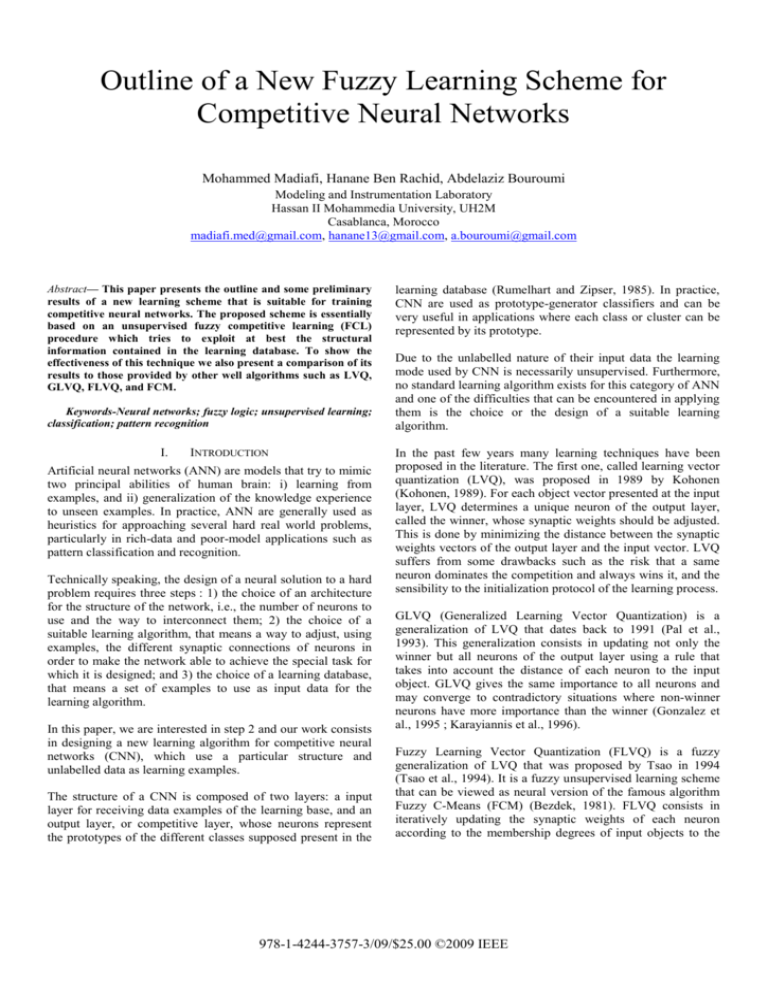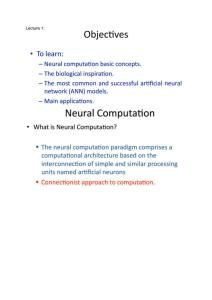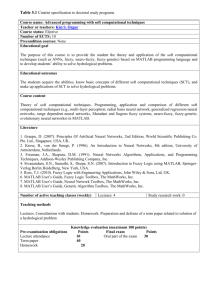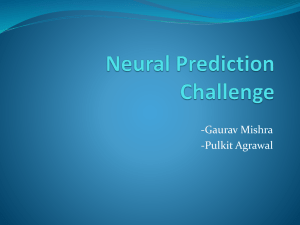II. Competitive Neural Networks
advertisement

Outline of a New Fuzzy Learning Scheme for
Competitive Neural Networks
Mohammed Madiafi, Hanane Ben Rachid, Abdelaziz Bouroumi
Modeling and Instrumentation Laboratory
Hassan II Mohammedia University, UH2M
Casablanca, Morocco
madiafi.med@gmail.com, hanane13@gmail.com, a.bouroumi@gmail.com
Abstract— This paper presents the outline and some preliminary
results of a new learning scheme that is suitable for training
competitive neural networks. The proposed scheme is essentially
based on an unsupervised fuzzy competitive learning (FCL)
procedure which tries to exploit at best the structural
information contained in the learning database. To show the
effectiveness of this technique we also present a comparison of its
results to those provided by other well algorithms such as LVQ,
GLVQ, FLVQ, and FCM.
Keywords-Neural networks; fuzzy logic; unsupervised learning;
classification; pattern recognition
I.
INTRODUCTION
Artificial neural networks (ANN) are models that try to mimic
two principal abilities of human brain: i) learning from
examples, and ii) generalization of the knowledge experience
to unseen examples. In practice, ANN are generally used as
heuristics for approaching several hard real world problems,
particularly in rich-data and poor-model applications such as
pattern classification and recognition.
Technically speaking, the design of a neural solution to a hard
problem requires three steps : 1) the choice of an architecture
for the structure of the network, i.e., the number of neurons to
use and the way to interconnect them; 2) the choice of a
suitable learning algorithm, that means a way to adjust, using
examples, the different synaptic connections of neurons in
order to make the network able to achieve the special task for
which it is designed; and 3) the choice of a learning database,
that means a set of examples to use as input data for the
learning algorithm.
In this paper, we are interested in step 2 and our work consists
in designing a new learning algorithm for competitive neural
networks (CNN), which use a particular structure and
unlabelled data as learning examples.
The structure of a CNN is composed of two layers: a input
layer for receiving data examples of the learning base, and an
output layer, or competitive layer, whose neurons represent
the prototypes of the different classes supposed present in the
learning database (Rumelhart and Zipser, 1985). In practice,
CNN are used as prototype-generator classifiers and can be
very useful in applications where each class or cluster can be
represented by its prototype.
Due to the unlabelled nature of their input data the learning
mode used by CNN is necessarily unsupervised. Furthermore,
no standard learning algorithm exists for this category of ANN
and one of the difficulties that can be encountered in applying
them is the choice or the design of a suitable learning
algorithm.
In the past few years many learning techniques have been
proposed in the literature. The first one, called learning vector
quantization (LVQ), was proposed in 1989 by Kohonen
(Kohonen, 1989). For each object vector presented at the input
layer, LVQ determines a unique neuron of the output layer,
called the winner, whose synaptic weights should be adjusted.
This is done by minimizing the distance between the synaptic
weights vectors of the output layer and the input vector. LVQ
suffers from some drawbacks such as the risk that a same
neuron dominates the competition and always wins it, and the
sensibility to the initialization protocol of the learning process.
GLVQ (Generalized Learning Vector Quantization) is a
generalization of LVQ that dates back to 1991 (Pal et al.,
1993). This generalization consists in updating not only the
winner but all neurons of the output layer using a rule that
takes into account the distance of each neuron to the input
object. GLVQ gives the same importance to all neurons and
may converge to contradictory situations where non-winner
neurons have more importance than the winner (Gonzalez et
al., 1995 ; Karayiannis et al., 1996).
Fuzzy Learning Vector Quantization (FLVQ) is a fuzzy
generalization of LVQ that was proposed by Tsao in 1994
(Tsao et al., 1994). It is a fuzzy unsupervised learning scheme
that can be viewed as neural version of the famous algorithm
Fuzzy C-Means (FCM) (Bezdek, 1981). FLVQ consists in
iteratively updating the synaptic weights of each neuron
according to the membership degrees of input objects to the
978-1-4244-3757-3/09/$25.00 ©2009 IEEE
classes represented by that neuron. FLVQ requires prior
availability of all elements of the learning database and cannot
be used online, i.e., in situations where learning data are not
all available before starting the learning process. FLVQ can
also be costly in terms of time processing, especially for large
learning databases.
In this paper, we propose a new fuzzy learning technique,
called Fuzzy Competitive Learning (FCL), which tries to
overcome the main drawbacks of the previous techniques.
FCL can be viewed as an intermediary between LVQ and
FLVQ in the sense that at each step of the learning process a
number of winners is determined that can vary between 1 and
the total number of classes. This number is determined using a
new parameter we introduced in order to model the difficulty
degree of the competition. Initially, this degree is small, which
means that all neurons can win it ; but as the learning process
progresses competition becomes harder and harder causing a
decrease of the number of winners. More details of this
technique are given in section IV. Examples of results of its
application to test data are presented and discussed in section
V, whilst sections II and III recall, respectively, the
architecture of CNN and their first learning algorithm, LVQ.
For detailed description of other algorithms we invite the
reader to consult the corresponding bibliography.
II.
COMPETITIVE NEURAL NETWORKS
Competitive neural networks constitute a particular class of
ANN. They are commonly used for solving hard real-world
problems such as pattern classification and recognition, image
compressing, etc.
CNN possess a two-layer architecture. The first layer is
composed of p neurons with p denoting the number of features
per object, i.e., the dimension of the data space. It is an input
layer whose role is to receive the p-dimensional object vectors
representing the n examples of the learning base. The second
layer, or output layer, contains c neurons where c is the
number of classes supposed present in the learning base. The p
synaptic weights of each of these neurons represent the
components of vector prototype of a class (Figure1).
examples are unlabeled. In the next section we give a more
detailed description of different variants of LVQ.
III.
LEARNING ALGORITHMS FOR CNN
A. Learning Vector Quantization (LVQ)
LVQ is an unsupervised learning algorithm aimed at
training competitive neural networks. It is based on the idea of
competition in the sense that, at each iteration, the c neurons
of the output layer compete for the input sample and only one
neuron, the winner, benefits from the adjustment of its
synaptic weights.
Hence, for each object vector
x
x
,x,...,x
i
i1 i2
ip
p
presented to the network, we locate the neuron j whose
v
,v,...,v
minimizes
synaptic weights vector v
j
j1 j2
jp
p
the distance xi v j . This vector is then updated according to
the rule:
v
v
(
x
v
)
(1)
jt
,
jt
,
1
t
1 i
jt
,
1
t 1 is the learning rate which serves to control the
convergence of synaptic weights vectors to class prototypes.
Starting from an initial value 0 , t 1 is updated, at each
iteration t, according to the relation :
t 0 1 t
(2)
tmax
This operation is repeated until stabilization of synaptic
weights vectors or until a maximum number of iterations is
reached.
As mentioned before, LVQ suffers from some drawbacks
such as its sensitivity to the initialization, the risk of a
dominant that always wins the competition, and a bad
exploitation of the structural information carried by each data
example. Indeed this information is not limited to the distance
between the data example and the winner but distributed over
the distances to all the c neurons.
To overcome these drawbacks several techniques have
been proposed in the literature. The earliest technique was a
generalization of LVQ known under the noun: Generalized
Learning Vector Quantization (GLVQ).
Figure1. Architecture of a CNN
B. Generalized LVQ
Proposed by Pal, GLVQ is an optimization procedure that tries
to minimize the following criterion :
c
As mentioned in the introduction, LVQ was the first
algorithm used to train this kind of ANN. LVQ exists on the
form of different versions called LVQ1, LVQ2, LVQ3, and
LVQ4. The three first versions use a supervised learning mode,
which needs that the data examples are labeled. As to the last
version it uses an unsupervised learning mode for which
xv
J
i
j
1
with
ji
i
jt
,
1
2
(3)
1
s
i j
a
r
g
{
m
i
n
(
xv
)
}
i
r
,
t
1
1
r
c
1
1
j
i
A
i
l
l
e
u
r
s
c
2
D
xv
i
r
,
t
1
r
1
This is done by updating the synaptic weights of all neurons of
the output layer using the rule :
J
i
v
v
jt
,
jt
,
1
t
1
v
jt
,
1
that is:
2
D
D
x
v
i
j
,1
t
vv
x
v
j
,
t
j
,1
t
t
1
i
j
,1
t
2
D
s
i j
a
r
g
{
m
i
n
(x
v
)
}
i
r
,t
1
(4.1)
2
1
rc
2
x
v
i
j
,1
t
(4.2)
vv
x
v
i
n
o
n
S
j
,
t
j
,1
t
t
1
i
j
,1
t
2
D
By analyzing relation (4) we can see that GLVQ allows all
output neurons to be updated; but gives the same importance
to all non-winners, which can be inconvenient. In addition,
when D 0,1 , non-winner neurons will have more
importance than the winner, which is inacceptable.
and in FLVQ it increases according to :
t
mm
m
(
m
m
)
t
i
n
m
a
x
m
i
n
t
m
a
x
The pseudo codes of FLVQ and FLVQ as well as FCM
are recalled hereafter.
Unlike LVQ and GLVQ, FLVQ and FCM use a learning
mode that requires the prior availability of the totality of data
examples before starting the learning phase. This means that
FLVQ and FCM cannot be used online, i.e., in situations
where data are continually arriving.
IV.
FUZZY COMPETITIVE LEARNING (FCL)
In this section we present a new technique called Fuzzy
Competitive Learning that we have designed in order to
remedy to the drawbacks of previously described methods.
FCL is an optimization procedure that seeks to minimize the
following criterion:
c
E
u
x
v
it
,
jit
,
i
jt
,
1
1
1
c
2
m
1
x
v
i
j,t
1
ujit,
r1
xv 2
i rt, 1
u
c
m
xi
ji ,t
vj ,t
r 1
u
c
(5.1)
(5.2)
m
(7)
j
1
where u ji ,t denotes a similarity measure between the object xi
and the prototype
C. Fuzzy Learning Vector Quantization (FLVQ)
In attempt to better exploit the structural information
carried by each data example, Tsao et al. proposed a variant of
LVQ for which all neurons are declared winners but with
different degrees. This variant is called Fuzzy Learning Vector
Quantization and can be viewed as a neural version of the
famous algorithm Fuzzy C-Means (FCM). In fact, like FCM,
FLVQ uses the following expressions for calculating
membership degrees and prototypes vectors :
(6.2)
vj
which represents the jth class.
x
v
v
x
is the distance between xi and
i
jt
,
1
i
k
j
k
,t
1
p
2
k
1
vj .
Ei ,t can be interpreted as the global error incurred when we
replace each object by the prototype of the class to which it
belongs.
As a measure of similarity we used the expression :
1
0
ujit
,
1
x v
i
jt
,
1
c
1
x
v
i
rt
,
1
r
1
s
i
x
i vjt
,
1
s
i
r j te
lq
u
e x
i v
rt
,
1
A
ille
u
r
s
(8)
ji ,t
r 1
The difference between FCM and FLVQ concerns the m
parameter, which is constant for FCM but variable for FLVQ.
Depending on the way m varies throughout iterations two
versions of FLVQ have been developed: FLVQ and
FLVQ. In FLVQ, m decreases according to the relation :
t
mm
m
(
m
m
)
(6.1)
t
a
x
m
a
x
m
i
n
t
m
a
x
From equation (8) we can easily see that u ji ,t verifies the three
properties:
1)
0uji,t 1
c
2)
u
j 1
ji ,t
1
compare algorithms, and we compare these results to those
provided by the other studied algorithms.
n
3)
u
ji ,t
0
i 1
This means that u ji ,t can also be interpreted as a measure of
the membership degree of
xi to the jth class.
To obtain the rule of adjusting the synaptic weights of output
neurons we calculate the derivative of (8) according to the
principle of backpropagation.
E
it
,
v
v
jt
,
jt
,
1
t
1
v
jt
,
1
That means:
(
x
v
)
i
j
,
t
1
2
v
v
c
u
j
,
t
j
,
t
1
t
1j
i
,
t
x
v
i
j
,
t
1
(9.1)
In the particular case where xi vj,t1 0, we obtain :
v j ,t v j ,t 1
(9.2)
t 1 is the learning rate whose initial value, fixed by the user.
x
,x,...,x
of the
Hence, for each objet x
i
i1 i2
ip
learning base, we can use eq. (5.1) to calculate the
membership degree of xi to each class and then adjust the
prototype of this class using eq. (9.1) or (9.2). In this case, all
prototypes, including those who are very far from xi, are
considered as winners and benefit from the adjustment of their
components. To avoid unnecessarily update far prototypes we
have introduced a new parameter 0,1 which serves as a
p
measure of the difficulty degree of the competition. Using this
parameter we can control the number of winners at each
iteration and limit the updating process to prototypes that
present a sufficient similarity with the input datum.
Hence, in order to be considered as a winner each neuron j
should verify the condition u ji ,t .
For this, four well-known data sets have been considered:
1- IRIS data is a set of 150 4-dimensional vectors
representing each the measures in cm of the length
and width of sepal and petal of an iris flower. The
dataset consists of 50 samples from each of three
different classes: Setosa, Versicolor and Virginia. One
of the main characteristics of this example is that one
of the three classes is well separated from the other
two which present an important overlapping, making
it difficult to separate them.
2- BCW data set contains 699 vectors of 9 dimensions,
originated from two classes of different size. The first
class contains 458 samples and the second 241. These
are numerical data extracted from medical images
related to breast cancer.
3- Yeast data set is related protein localization and
contains 1484 8-dimensional vectors, distributed over
10 different classes of different size.
4- Spect data set is a medical database of 267 vectors of
22 dimensions originated from two different classes of
heart-disease.
A first comparison is based on the misclassification error rate
defined by:
N
u
m
b
e
ro
fm
i
s
c
l
a
s
s
i
f
i
e
d
o
b
j
e
c
t
s
e
N
u
m
b
e
ro
fo
b
j
e
c
t
s
Misclassification error rates of each of the six studied learning
algorithms are reported, for each data set, on Table I.
TABLE I.
Initially 0 , meaning that the competition is supposed easy
and all prototypes have a chance to be adjusted. But as the
learning process progresses the competition becomes more
and more difficult, increases, and the number of winners
decreases. The variation of throughout iterations was
heuristically determined and the mathematical expression we
adopted for this study is:
( t )2
(10)
tmax
V.
EXPERIMENTAL RESULTS AND DISCUSSION
In this section, we present typical examples of results provided
by the proposed algorithm for a variety of real test data,
commonly used in the literature as benchmarks to test and
Database
MISCLASSIFICATION ERROR RATES
Technique
LVQ
FCM
FLVQ
FLVQ
GLVQ
FCL
IRIS
10,666
10,666
10,666
11,333
11,333
10
BCW
14,587
14,587
14,587
14,938
14,587
14,587
Yeast
70,081
60,714
67,52
71,024
-
59,299
Spect
43,82
39,7
39,7
39,7
-
32,209
The second comparison is based on the running time of each
method. The dataset used for this comparison is a 129x129
IRM image originated from the McConnell cerebral imagery
center (Figure2.a).
Figure 3 depicts the variation of running time of each algorithm
with the number of prototypes.
shows the misclassification error rate, while Table III gives
the confusion matrix.
TABLE II.
(a)
(d)
(b)
(e)
(c)
(f)
Figure2. Original and segmented IRM images of the human brain;
(a) Original image, (b) Segmented by LVQ, (c) Segmented by GLVQ, (d)
Segmented by FLVQ , (e) Segmented by FCM, (f) Segmented by FCL
Initialization
MISCLASSIFICATION ERROR RATES FOR THE THREE STUDIED
INITIALIZATION MODES WITH IRIS DATA
Technique
LVQ
FCM
FLVQ
FLVQ
GLVQ
FCL
Mode1
66,666
10,666
10
11,333
66,666
10,666
Mode2
10,666
10,666
10,666
11,333
11,333
10
Mode3
10,666
10,666
10,666
11,333
11,333
10
Finally, in figure 4 we present the evolution of running
time and error rate with the learning rate , which is one of the
most important parameters of our method. As we can see, the
choice of can influence both the running time and error
rate.
a
b
FIGURE4. EVOLUTION OF THE RUNNING TIME (A) AND THE ERROR RATE (B)
WITH THE LEARNING RATE
TABLE III.
FLVQ
FCM
FCL
GLVQ
LVQ
Initialization
Mode1
Figure3. Evolution of the running time in seconds with the number of
prototypes
The first comparison concerns the sensitivity of each
method to the prototypes initialization technique. It is based
on the results obtained for the Iris data. For this, three different
initialization modes were studied :
1- Random initialization, which consists in choosing
random initial components for each prototype.
2- Initialization of each component by a random value
comprised between two limits that ensure that initial
prototypes belong to the data space defined by the
learning database.
3- Each prototype is initialized using a object vector of
the learning database.
Results of this part are reported on Tables II and III. For
each initialization mode and each learning algorithm Table II
Mode2
Mode3
CONFUSION MATRICES
Technique
LVQ
50 0 0
50 0 0
50 0 0
50 0 0
0 47 3
0 13 37
50 0 0
0 47 3
0 13 37
FCM
50
0
0
50
0
0
50
0
0
FCL
0
3
37
0
3
37
0 0
47 3
13 37
0
47
13
0
47
13
50
0
0
50
0
0
50
0
0
0
2
37
0
2
37
0 0
47 3
13 37
0
48
13
0
48
13
The previous results show that, globally, the performances
of the proposed method (FCL) are better than those of other
well-known methods. Indeed, as we can easily see both the
misclassification error rate and the running time of FCL are
less than those observed for all the other methods. Annother
advantage of FCL is its ability to converge to the best
prototypes for different initialization modes, which is not the
case for other algorithms.
VI.
CONCLUSION
In this paper, we presented a new unsupervised learning
algorithm for competitive neural networks, called Fuzzy
Competitive Learning (FCL). This algorithm has been applied
to different test data sets, including images data, and its results
favorably compared to those produced, for the same data, by
other well-known algorithms including LVQ, GLVQ, FLVQ
and FCM. These encouraging results justify the continuation
of this study in order, for example, to avoid the sensitivity to
initialization, which remains a common problem for many
problems.
[4]
[5]
[6]
[7]
[8]
[9]
[10]
[11]
[12]
REFERENCES
[1]
[2]
[3]
http://www.bic.mni.mcgill.ca/brainweb/.
A. Badi, K. Akodadi, M. Mestari, A. Namir, A Neural-Network to
Solving the Output Contention in Packet Switching Networks, Applied
Mathematical Sciences, Vol. 3, 2009, no. 29, 1407 – 1451.
Ma Yumei, Liu Lijun, Nan Dong, A Note on Approximation Problems
of Neural Network, International Mathematical Forum, 5, 2010, no.
41, 2037 – 2041.
[13]
Toly Chen, Yu-Cheng Lin, A fuzzy back propagation network
ensemble with example classification for lot output time prediction in
a wafer fab, Applied Soft Computing 9, 2009, 658–666.
Pablo Alberto Dalbem de Castro, Fernando J. Von Zuben, BAIS: A
Bayesian Artificial Immune System for the effective handling of
building blocks, Information Sciences 179, 2009, 1426–1440.
Rodrigo Pasti, Leandro Nunes de Castro, B io-inspired and gradientbased algorithms to train MLPs: The influence of diversity,
Information Sciences 179, 2009, 1441–1453.
D. Guan, W. Yuan, Y-K. Lee, S. Lee, Nearest neighbor editing aided
by
unlabeled
data,
Information
Sciences,
2009,
doi:
10.1016/j.ins.2009.02.011.
Lizhi Peng, Bo Yang, Yuehui Chen, Ajith Abraham, Data gravitation
based classification, Lizhi Peng, Bo Yang, Yuehui Chen, Ajith
Abraham.
N. R. Pal, J. C. Bewdek, R. J. Hathaway, Sequential Competitive
Learning and the Fuzzy c-Means Clustering Algorithms, Neural
Networks, Vol. 9, 1996, no. 5, 787 – 796.
A. Riul, H. C. de Sousa, R. R. Malmegrim, D. S. dos Santos, A.
C.P.L.F. Carvalho, F. J. Fonseca, O. N. Oliveira, L. H.C. Mattoso,
Wine classification by taste sensors made from ultra-thin films and
using neural networks, Sensors and Actuators B 98, 2004, 77 – 82.
Robert Cierniak, Leszek Rutkowski, On image compression by
competitive neural networks and optimal linear predictors, Signal
Processing: Image Communication, 15, 2000, 559 – 565.
D.L. Collins, A.P. Zijdenbos, V. Kollokian, J. Sled, N.J. Kabani, C.J.
Holmes, and A.C. Evans, Design and construction of a realistic digital
brain phantom,” IEEE Transactions on Medical Imaging, vol. 17,
1998, no. 3, 463 – 468.
C.A. Cocosco, V. Kollokian, R.K.-S. Kwan, A.C. Evans, BrainWeb:
Online Interface to a 3D MRI Simulated Brain Database, NeuroImage,
vol. 5 1997, no. 4, part 2/4, S425 — Proceedings of 3-rd International
Conference on Functional Mapping of the Human Brain, Copenhagen.








